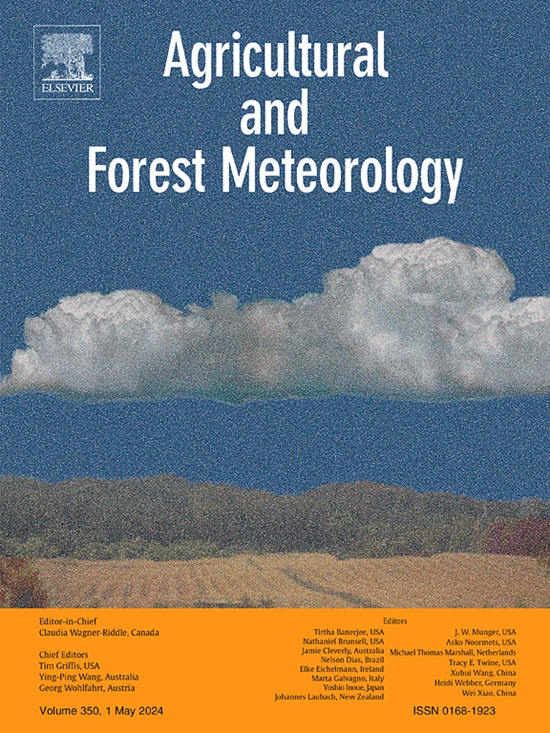Carbon fluxes controlled by land management and disturbances at a cluster of long-term ecosystem monitoring sites in Central Europe
IF 5.6
1区 农林科学
Q1 AGRONOMY
引用次数: 0
Abstract
Terrestrial ecosystems play a crucial role in carbon sequestration and provide vital ecosystem services such as food, energy, and raw materials. Climate change, through rising temperatures, altered precipitation patterns, and extreme events, threatens the carbon sink potential of these ecosystems, with forests and grasslands particularly at risk. Long-term data from flux tower networks offer valuable insights into how different ecosystems respond to climate change and management interventions, helping to develop strategies to mitigate greenhouse gas emissions and maintain ecosystem resilience. In this study, we present such data from a <10 km cluster of long-term FLUXNET/ICOS sites in Central Europe, comprising an old spruce forest (DE-Tha), a young oak plantation after a cleared windthrow (DE-Hzd), a permanent grassland site (DE-Gri), and an agricultural site with a crop rotation typical for this region (DE-Kli). By analysing decades of data from these eddy covariance measurement sites, the research highlights the influence of drought, management, and land cover changes on CO2 and H2O fluxes. The interannual variability of evapotranspiration depends less on land use than the CO2 exchange. Our findings show that intact forests can act as larger carbon sinks than previously estimated. DE-Tha is a consistent carbon sink, with thinning helping to maintain the CO2 sequestration at a stable level of 350 gC m−2 a−1. In contrast, disturbances like clear cutting or windthrow can cause ecosystems to become carbon sources for several years, with recovery delayed due to soil carbon losses from increased respiration (DE-Hzd). While DE-Hzd was resilient to drought, the carbon uptake of DE-Tha was significantly reduced by around 50 % during dry years compared to wet years. Furthermore, sustainable management maintains carbon sequestration and land-use practices, such as crop selection, significantly impact net ecosystem productivity. These insights are valuable for optimizing land management strategies to enhance carbon sinks in similar regions.
中欧一组长期生态系统监测点的土地管理和干扰控制的碳通量
陆地生态系统在固碳方面发挥着至关重要的作用,并提供重要的生态系统服务,如食物、能源和原材料。气候变化通过气温上升、降水模式改变和极端事件,威胁着这些生态系统的碳汇潜力,森林和草原尤其面临风险。通量塔网络的长期数据为了解不同生态系统如何应对气候变化和管理干预措施提供了宝贵的见解,有助于制定减少温室气体排放和保持生态系统复原力的战略。在这项研究中,我们提供了来自中欧一个10公里的长期FLUXNET/ICOS站点集群的数据,包括一个古老的云杉林(DE-Tha),一个清除风后的年轻橡树种植园(DE-Hzd),一个永久草地(DE-Gri)和一个该地区典型的轮作农业站点(DE-Kli)。通过分析这些涡动相关测量站点数十年的数据,该研究强调了干旱、管理和土地覆盖变化对CO2和H2O通量的影响。蒸散发的年际变化对土地利用的依赖比对CO2交换的依赖要小。我们的研究结果表明,完整的森林可以作为比以前估计的更大的碳汇。DE-Tha是一个稳定的碳汇,减薄有助于将CO2固存维持在350 gC m−2 a−1的稳定水平。相比之下,砍伐或风吹等干扰可使生态系统在数年内成为碳源,由于呼吸增加导致的土壤碳损失而延迟恢复(DE-Hzd)。虽然DE-Hzd对干旱具有弹性,但与潮湿年份相比,DE-Tha的碳吸收量在干旱年份显着减少了约50%。此外,可持续管理维持碳固存和土地利用做法,如作物选择,对生态系统净生产力产生重大影响。这些见解对于优化土地管理战略以增强类似地区的碳汇具有重要价值。
本文章由计算机程序翻译,如有差异,请以英文原文为准。
求助全文
约1分钟内获得全文
求助全文
来源期刊
CiteScore
10.30
自引率
9.70%
发文量
415
审稿时长
69 days
期刊介绍:
Agricultural and Forest Meteorology is an international journal for the publication of original articles and reviews on the inter-relationship between meteorology, agriculture, forestry, and natural ecosystems. Emphasis is on basic and applied scientific research relevant to practical problems in the field of plant and soil sciences, ecology and biogeochemistry as affected by weather as well as climate variability and change. Theoretical models should be tested against experimental data. Articles must appeal to an international audience. Special issues devoted to single topics are also published.
Typical topics include canopy micrometeorology (e.g. canopy radiation transfer, turbulence near the ground, evapotranspiration, energy balance, fluxes of trace gases), micrometeorological instrumentation (e.g., sensors for trace gases, flux measurement instruments, radiation measurement techniques), aerobiology (e.g. the dispersion of pollen, spores, insects and pesticides), biometeorology (e.g. the effect of weather and climate on plant distribution, crop yield, water-use efficiency, and plant phenology), forest-fire/weather interactions, and feedbacks from vegetation to weather and the climate system.

 求助内容:
求助内容: 应助结果提醒方式:
应助结果提醒方式:


